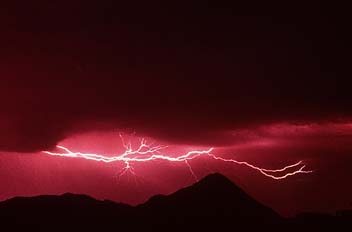What Causes Lightning?


Photos courtesy of www.strikingimages.com
The occurance of lightning is a result of a build up of electrostatic charge within clouds. Initially, the positive and negative charges inside the cloud separate with the negative charges usually heading to the bottom of the cloud and the positive charges migrating toward the top. Once this happens, the negative charge will jump from the cloud and connect with either the ground or another cloud. This process is animated in the little dittyshow seen below.

The collection of negative charge near the bottom of the cloud forces the negative charges in the ground away from the surface. This leaves the ground with an excess positive charge. A small collection of negative charge called a streamer is then repelled by from the bottom of the cloud due to the overabundance of charge located there. This negatively charged streamer is then attracted by the positively charged ground. As the negatively charged streamer leaves the cloud it is attracted to a positively charged streamer being repelled from the ground. The streamers are drawn to one another until they connect and thereby create a highly conductive path through which a large surge of electrons are allowed to flow to the ground. This effect is observed visually as lightning. The collection of electrons moves so fast that they excite the air surrounding the conducting path and thereby cause this region of space to emit some light.

This videoclip documents a rather amazing interaction of lighting with an airborne plane.